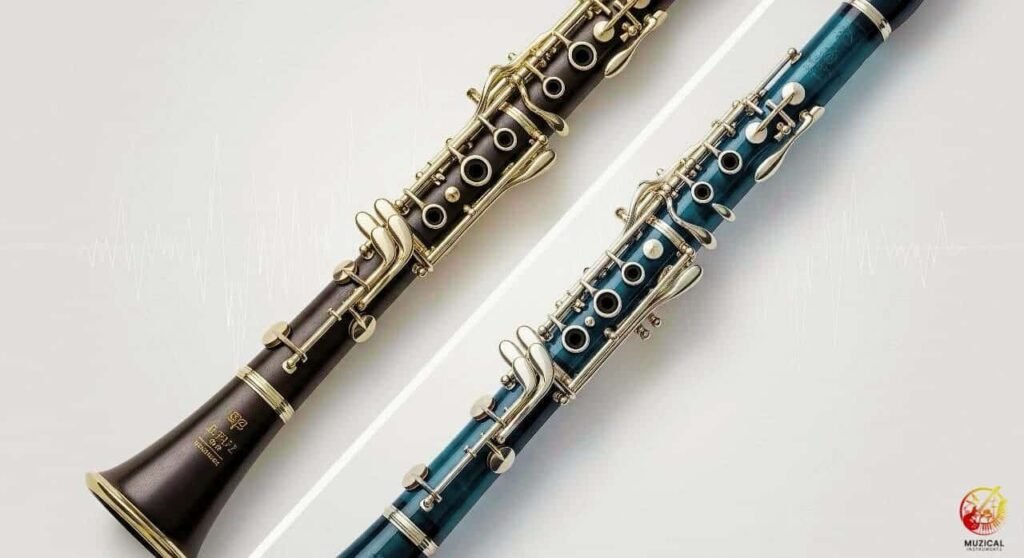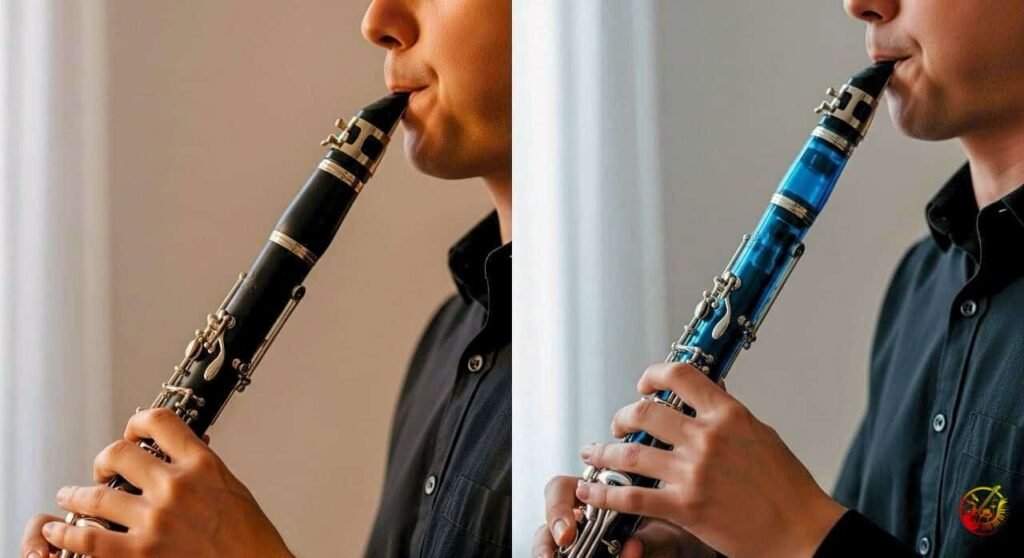Does Clarinet Material Change the Sound?
Does clarinet material change the sound? Yes, but not in the way many players expect. For decades, clarinetists, teachers, and even instrument makers have debated whether wood, plastic, or composite bodies make a noticeable difference. The truth is more layered. Sound is shaped by many factors: reed, mouthpiece, player’s embouchure, and yes, the material of the instrument itself.
If you play in a marching band, you may wonder why plastic clarinets are the norm. If you sit in an orchestra, you’ve probably seen grenadilla wood models in every section. Why is that? What real difference does the material make in tone, projection, and feel?
In this article, you’ll learn how clarinet materials influence sound, how much the player matters compared to the instrument, and what practical differences exist between wood, plastic, and newer hybrid options.
You’ll also see expert insights, comparison tables, and advice on choosing the right material for your playing goals.
Does clarinet material change the sound more than other factors?

When people ask, does clarinet material change the sound, the short answer is yes, but the effect is subtle compared to other variables. The material influences how vibrations travel through the instrument and how air resonates inside the bore.
Wooden clarinets, typically made from grenadilla (African blackwood), produce a warm, dark tone with more tonal complexity. Many orchestral musicians describe this as “rich” or “resonant.” Plastic clarinets, often made of ABS resin, project a brighter, slightly more direct sound. In outdoor settings, this clarity is a strength, helping the instrument cut through wind and background noise.
However, it’s important to understand that 80–90% of your sound still comes from your reed, mouthpiece, and playing technique. Two players using the same clarinet can sound drastically different. That’s why some blind tests show listeners can’t always tell plastic from wood, especially when played by a professional.
Pro Tip: Don’t overthink material at the beginner stage. If you’re just learning, your embouchure and breath support will shape your sound more than wood vs. plastic ever will.
Why are professional clarinets usually made of grenadilla wood?

Grenadilla wood is the gold standard for professional clarinets. Why? Because its density and stability create a particular resonance that players value. This African hardwood has been used for centuries in woodwinds, not only for clarinets but also oboes, bassoons, and even bagpipes.
Grenadilla adds depth to the tone. When you play softly, it helps create a velvety, round sound. When you push harder, the instrument projects powerfully without losing warmth. That flexibility is crucial in classical performance, where you need to move between intimate chamber pieces and large orchestral works.
But grenadilla has drawbacks. It’s sensitive to humidity and temperature changes, which can lead to cracks. It also requires regular oiling and careful storage. For these reasons, student instruments are rarely made from it.
Expert Insight: Many professionals believe grenadilla clarinets provide better “color” in the sound subtle shadings that make music more expressive. But they also admit that a skilled player can sound wonderful on resin models.
Grenadilla Wood vs. Plastic Clarinet
| Feature | Grenadilla Wood | Plastic (ABS Resin) |
|---|---|---|
| Tone quality | Warm, rich, complex | Bright, clear, straightforward |
| Projection | Strong but rounded | Direct, focused |
| Durability | Can crack, needs care | Very durable, weatherproof |
| Maintenance | Needs oiling, careful storage | Low maintenance |
| Common use | Professional, orchestral | Beginners, marching bands |
Are plastic clarinets only for beginners?
Not at all. While plastic clarinets are marketed to students because of cost and durability, they also serve advanced players in specific settings. Marching bands, outdoor gigs, and school ensembles often prefer them because they can withstand rain, humidity, and temperature swings that would destroy a wooden instrument.
Modern ABS clarinets, like the Yamaha YCL-255, have excellent intonation and playability. In blind listening tests, even trained ears sometimes struggle to distinguish between high quality plastic and mid range wooden clarinets.
Some professionals even keep a plastic clarinet as a “backup horn” for travel or harsh conditions. If you’re gigging outside at a wedding or festival, you may not want to risk your grenadilla.
Pro Tip: If you plan to practice in different climates or travel a lot, owning both a wood and a plastic clarinet gives you flexibility without sacrificing tone quality in safe environments.
So while wood dominates the concert stage, plastic plays a vital role in real-world performance.
Do alternative materials like ebonite or carbon fiber change the sound?
Yes, and they’re becoming more popular. Ebonite (hard rubber) and carbon fiber are alternatives designed to balance tone quality with durability.
Ebonite (hard rubber)
Offers a tone closer to wood, with warmth and resonance but greater stability. Some boutique clarinets use this to mimic grenadilla without the cracking risks.
Carbon fiber
Lightweight, extremely strong, and weather resistant. It reflects vibrations differently than wood, often producing a brighter, more focused sound. Though rare, carbon fiber clarinets appeal to players who need projection and durability without heavy maintenance.
Composite (wood-resin blends)
Buffet’s Greenline clarinets are a prime example. They mix grenadilla powder with resin, creating instruments nearly indistinguishable from solid wood in sound but resistant to environmental damage.
Alternative Clarinet Materials
| Material | Tone Character | Strengths | Weaknesses |
|---|---|---|---|
| Ebonite (hard rubber) | Warm, close to wood | Stable, no cracking | Slightly heavier |
| Carbon fiber | Focused, bright | Lightweight, weatherproof | Expensive, uncommon |
| Wood-resin composite | Almost identical to wood | Crack-resistant, stable | Higher cost |
These alternatives won’t replace grenadilla in the concert hall anytime soon, but they expand options for players in varied environments.
What matters more: bore design or clarinet material?
Bore design often influences tone more than material. The bore, the internal shape and diameter of the clarinet, controls how air vibrates inside the instrument. Even two grenadilla clarinets from the same maker can sound different if their bores are cut differently.
Makers like Buffet and Selmer spend years refining bore designs to balance intonation, projection, and timbre. That’s why professional clarinets are graded not just by material but by “model family,” such as Buffet’s R13 vs RC.
Keywork precision also plays a major role. Poorly seated pads or leaky tone holes will ruin your sound, no matter how fine the wood is.
Analogy: Think of material as the canvas and bore design as the artist’s brushwork. The canvas matters, but the final painting depends more on design and execution.
So when comparing instruments, never judge by material alone, look closely at bore specifications and build quality.
Does player technique outweigh material differences?

Without question, yes. Even if you ask, does clarinet material change the sound more than technique? The answer leans heavily toward technique. Embouchure, breath support, and reed setup have a far greater impact.
Reeds are especially influential. A change in reed strength or brand can brighten or darken tone instantly. Mouthpieces also shape projection and resonance more dramatically than switching from wood to plastic.
Skilled clarinetists often prove this by making inexpensive plastic models sound beautiful, while beginners may struggle to produce a steady tone even on professional wood clarinets.
Pro Tip: Before investing in a new instrument, record yourself playing different reed and mouthpiece setups. You may find more improvement in tone and control this way than by changing body material.
This perspective explains why teachers emphasize fundamentals first. The clarinet is only a tool; artistry comes from the player.
Final Thoughts
So, does clarinet material change the sound? Yes, but it’s one piece of a bigger picture. Grenadilla wood delivers warmth and complexity prized in orchestras. Plastic clarinets shine in durability and outdoor use. Newer materials like ebonite, carbon fiber, and composites bridge gaps, offering fresh options for modern players.
Yet, the player remains the largest factor in tone. Bore design, reeds, mouthpiece, and technique often outweigh the difference between wood and plastic.
If you’re choosing your next clarinet, think less about material alone and more about your playing needs. Will you be outdoors? Traveling often? Seeking orchestral depth? The right match depends on your context.
In the end, the clarinet’s voice is your voice. Material matters, but your artistry matters most. Which will you focus on refining first?
FAQ: Does Clarinet Material Change the Sound?
1. What is the best material for a professional clarinet?
The most highly regarded material for professional clarinets is Grenadilla wood (African Blackwood). Its exceptional density provides a stable, non-resonant body that allows for a rich, dark, and complex tone full of overtones. Other high-quality woods like Cocobolo and innovative composite materials (like Green-Line) are also used for their unique tonal characteristics and enhanced durability.
2. Can a plastic clarinet sound good?
Absolutely. A well-made plastic (ABS resin) clarinet can sound very good, offering a clear, focused, and consistent tone. While it may not have the same depth of overtones as a professional wooden model, modern manufacturing has significantly improved its acoustic quality. For students, marching musicians, or players in extreme climates, a high-quality plastic clarinet is often the superior choice.
3. Why is Grenadilla wood so popular for clarinets?
Grenadilla wood is popular because of its physical properties. It is incredibly dense, stable, and resistant to moisture. Acoustically, this density means the wood itself doesn’t vibrate much; instead, it acts as a perfect container, reflecting the sound waves within the instrument’s bore with maximum efficiency. This results in the powerful, focused, and harmonically rich sound that professionals seek.
4. How can I make my clarinet sound richer?
The fastest way to achieve a richer sound has less to do with the clarinet’s body and more to do with your setup and technique.
Upgrade your mouthpiece and reed: This is the single most impactful change you can make. A professional-quality mouthpiece can transform your sound.
Improve your air support: Practice long tones to develop a steady, focused airstream. A rich sound is a well-supported sound.
Experiment with different reeds: The cut and strength of your reed have a huge effect on tone color.
5. Is it worth upgrading from a plastic to a wood clarinet?
For a serious, advancing student, upgrading from a plastic to a wood clarinet is almost always a worthwhile step. A wooden clarinet will offer a wider dynamic range and a more sophisticated tonal palette, allowing for greater musical expression. The instrument will feel more responsive, rewarding subtle changes in embouchure and air that a plastic model might not register.
6. What is a Green-Line or composite clarinet?
A composite clarinet, like Buffet Crampon’s “Green-Line” models, is made from a material that blends 95% Grenadilla wood powder with carbon fiber and an epoxy resin. This creates an instrument that retains most of the acoustic properties of wood but is completely resistant to cracking caused by changes in temperature and humidity, making it incredibly stable and reliable.
7. Does the metal on the keys (silver vs. nickel) change the sound?
No, the material of the keys does not have a discernible impact on the sound. The choice between nickel-plated and silver-plated keys is primarily about feel, durability, and aesthetics. Silver plating is generally considered to have a smoother feel under the fingers and is the standard on intermediate and professional instruments, but it requires more maintenance to prevent tarnishing.
